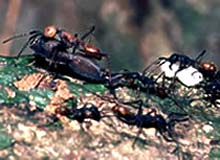When is an ant like a bicycle?

Little and large ants cooperate to carry a scorpion leg <br>© N.R. Franks
Army ants team little with large to lift heavy loads.
If you can’t see the point of the miniature back wheel on a penny-farthing bicycle, try riding a unicycle or watch an ant colony. Ants have realized that, to carry a heavy load, two supports are better than one – even if they seem comically mismatched.
When army ants partner up to carry a lump of food too big for a single ant to transport, an unusually large worker ant takes the front, and an unusually small one, the back, Nigel Franks of the University of Bristol, UK, and his colleagues have found1. Two such ants can carry a load heavier than the sum of their individual abilities.
An ant duo is like a penny-farthing, says Franks, because the big front provides power and steers. The small rear shifts the centre of gravity to between the two ends, making the whole system much more stable.
This is another example of how social insects rely on the colony to pass on genes that drive them to evolve sophisticated cooperation, explains evolutionary biologist Francis Ratnieks of the University of Sheffield, UK. Teamwork makes the most of the colony’s workforce.
Ants’ specialized division of labour is like that in a football team, says Ratnieks. “You can’t just choose 11 players at random, and the centre forward can’t play in goal.”
There are other big/small collaborations in insect societies, says Ratnieks. Such squads defend the nests of the European ant Pheidole pallidula against intruders from other colonies of the same species. “A lot of little ants hold the intruder down, and a big one comes along and chops its head off,” he says.
Team building
Rainforest army ants send out raiding parties of up to a quarter of a million individuals. These devour just about every invertebrate in their path, cutting them into chunks if necessary, and carting them back to the temporary nest. Franks and his colleagues found penny-farthing duos in the Central American Eciton burchelli and the smaller African Dorylus wilverthi.
How big and little ants team up is a mystery. Army ant lines move at a constant rate; an ant struggling with a lump of meat bigger than it can manage might attract helpers by causing traffic congestion.
When the researchers remove a team and put their food load back among the ants they see “a mêlée of workers, almost like a rugby scrum”, according to Franks. “Then – bang – the perfect team emerges, which weighs almost exactly the same as the first team,” he reports.
Ant alliances aren’t permanent. “They’re more like pick-up teams,” says Franks. They break up and do something else rather than go around looking for another piece of food equally well suited to their capabilities as a couple.
References
- Franks, N. R., Sendova-Franks, A. B. & Anderson, C. Division of labout within teams of New World and Old World army ants. Animal Behaviour, 62, 635 – 642, (2001).
Media Contact
All latest news from the category: Life Sciences and Chemistry
Articles and reports from the Life Sciences and chemistry area deal with applied and basic research into modern biology, chemistry and human medicine.
Valuable information can be found on a range of life sciences fields including bacteriology, biochemistry, bionics, bioinformatics, biophysics, biotechnology, genetics, geobotany, human biology, marine biology, microbiology, molecular biology, cellular biology, zoology, bioinorganic chemistry, microchemistry and environmental chemistry.
Newest articles

High-energy-density aqueous battery based on halogen multi-electron transfer
Traditional non-aqueous lithium-ion batteries have a high energy density, but their safety is compromised due to the flammable organic electrolytes they utilize. Aqueous batteries use water as the solvent for…

First-ever combined heart pump and pig kidney transplant
…gives new hope to patient with terminal illness. Surgeons at NYU Langone Health performed the first-ever combined mechanical heart pump and gene-edited pig kidney transplant surgery in a 54-year-old woman…

Biophysics: Testing how well biomarkers work
LMU researchers have developed a method to determine how reliably target proteins can be labeled using super-resolution fluorescence microscopy. Modern microscopy techniques make it possible to examine the inner workings…





















